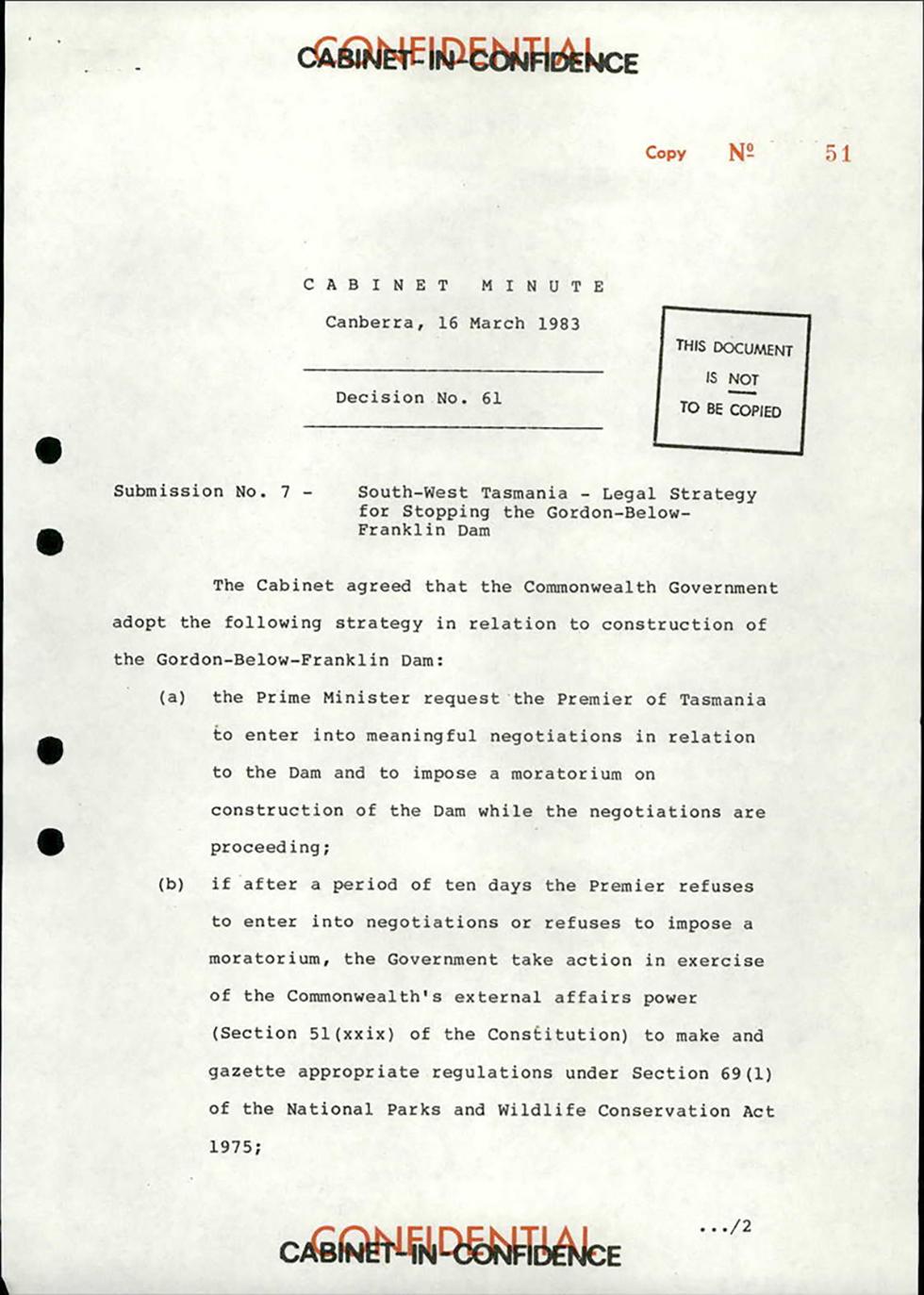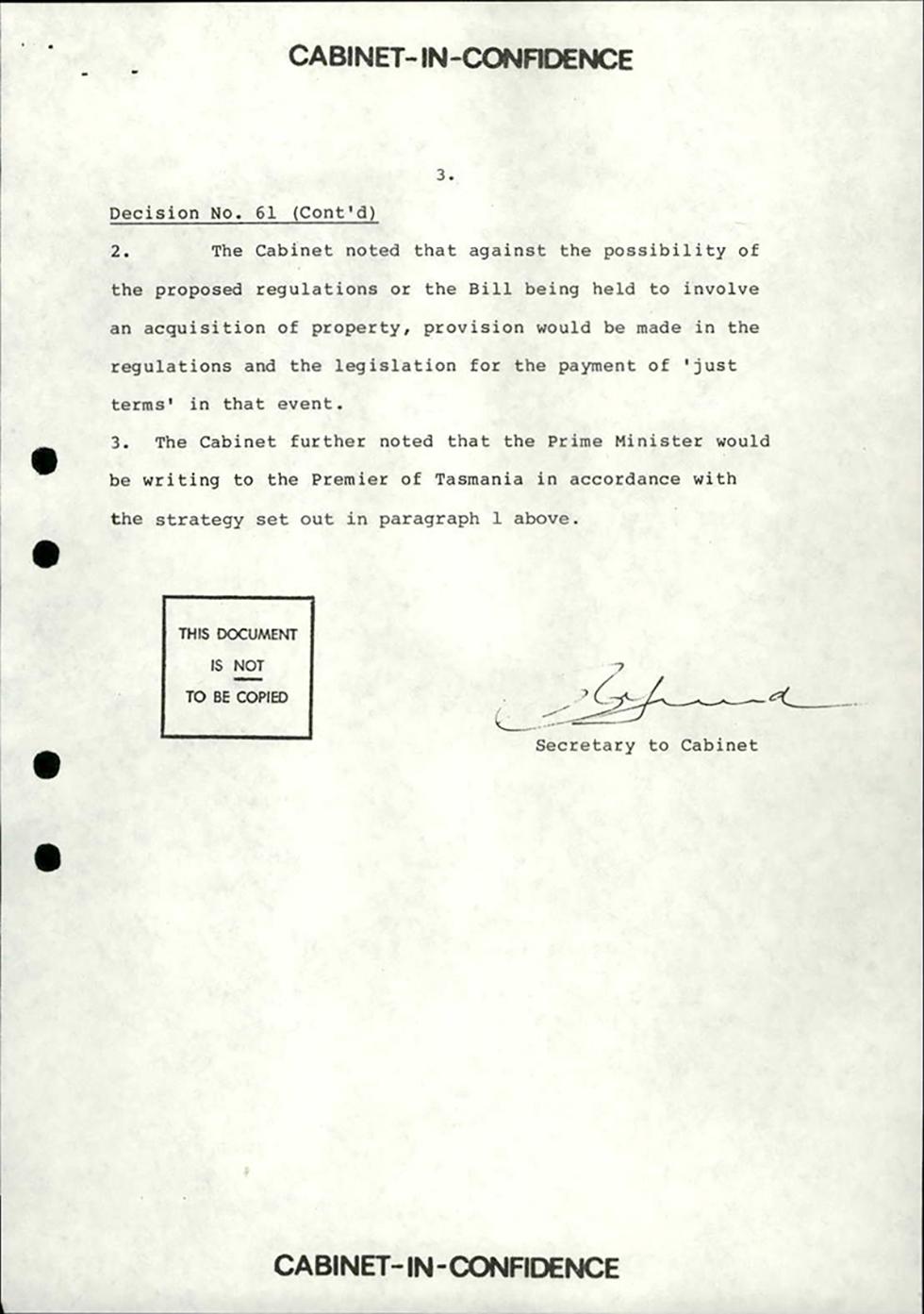


Aboriginal and Torres Strait Islander people should be aware that the National Archives' website and collection contain the names, images and voices of people who have died.
Some records include terms and views that are not appropriate today. They reflect the period in which they were created and are not the views of the National Archives.




[Page 1]
[Header and footer in red ink:] CONFIDENTIAL
[Header and footer in black ink:] CABINET-IN-CONFIDENCE
Copy No. 51
[Heading:] CABINET MINUTE
Canberra, 16 March 1983
[dividing line]
Decision No. 61
[dividing line]
[Stamped in black ink:] THIS DOCUMENT IS NOT [underlined] TO BE COPIED
[Subheading:] Submission No. 7 – South-West Tasmania – Legal Strategy for Stopping the Gordon-Below-Franklin Dam
The Cabinet agreed that the Commonwealth Government adopt the following strategy in relation to construction of the Gordon-Below-Franklin Dam:
(a) the Prime Minister request the Premier of Tasmania to enter into meaningful negotiations in relation to the Dam and to impose a moratorium on construction of the Dam while the negotiations are proceeding;
(b) if after a period of ten days the Premier refuses to enter into negotiations or refuses to impose a moratorium, the Government take action in exercise of the Commonwealth’s external affairs power (Section 51(xxix) of the Constitution) to make and gazette appropriate regulations under Section 69 (1) of the National Parks and Wildlife Conservation Act 1975;
…/2
[Page] 2.
[Header and footer in black ink:] CABINET-IN-CONFIDENCE
[Underlined heading] Decision No 61 (Cont’d)
(c) in the event that the regulations referred to in sub-paragraph (b) above are not heeded, the Commonwealth immediately seek injunctions in the High Court to stop work on the Dam;
(d) should the Tasmanian Government challenge the validity of the regulations, the Commonwealth seek interim injunctions pending the High Court's decision;
(e) in addition to the action referred to in sub-paragraph (a) to (d) above, the Commonwealth introduce into the Parliament, as soon as possible, a Bill, along the lines of the World Heritage Properties Protection Bill passed by the Senate last year, which would be drafted to take advantage of available Commonwealth powers, including the external affairs power; and
(f) the proposed Bill apply immediately to South-West Tasmania and potentially (if prescribed) to other World Heritage Properties that may become endangered.
[Stamped in black ink:] THIS DOCUMENT IS NOT [underlined] TO BE COPIED
…/3
[Page] 3.
[Header and footer in black ink:] CABINET-IN-CONFIDENCE
[Underlined heading] Decision No 61 (Cont'd)
2. The Cabinet noted that against the possibility of the proposed regulations or the Bill being held to involve an acquisition of property, provision would be made in the regulations and the legislation for the payment of 'just terms' in that event.
3. The Cabinet further noted that the Prime Minister would be writing to the Premier of Tasmania in accordance with the strategy set out in paragraph 1 above.
[Handwritten signature:] G Yeend
Secretary to Cabinet
[Stamped in black ink:] THIS DOCUMENT IS NOT [underlined] TO BE COPIED
This record shows Cabinet minutes for 16 March 1983. Cabinet is a group of government ministers who meet to discuss and make decisions on important national issues. This record relates to the recently elected Hawke government's plan to address the ongoing controversy over the contested Franklin-below-Gordon dam, which threatened to destroy a region that had been granted World Heritage status by the United Nations the previous year.
In January of 1983, Prime Minister Malcolm Fraser was attempting to negotiate with Tasmanian Premier Robin Gray to stop the planned construction of a hydroelectric dam that would flood the Franklin River. This included a promise of significant Federal Government investment to build a coal power station instead of the dam. Premier Gray repeatedly refused to negotiate on the topic of the dam, insisting that it was Tasmania's right as a state to manage their own waterways and that the dam was the most cost-effective option to meet the ongoing electricity needs of Tasmanians.
However, on the 5 March 1983, the Australian Labor Party (ALP) won the federal election. This election replaced Malcolm Fraser with a new Prime Minister, Bob Hawke. The ALP had made an election promise to stop construction of the Gordon-below-Franklin dam, and the media reported that this was one of the reasons for the change of government.
This record is dated 16 March 1983, only two working weeks after the election. It outlines the new government’s legal strategy for preventing the Gordon-below-Franklin dam should Premier Gray continue to refuse to negotiate on the topic.
In the first sitting of parliament after the election, the Hawke government set their legal strategy in motion by introducing the World Heritage Properties Conservation Bill (1983). The purpose of this Act was to establish the legal structure under which the Australian Government could protect World Heritage sites.
The part of the Constitution used to justify this was section 51(xxix). This section confers on the Australian parliament the right to make laws about external affairs (relations with other counties). As World Heritage sites are places that have significance to the entire world, the government decided the external affairs power in the Constitution could be interpreted to give them power to protect those places. However, the external affairs power had not been used in this way before.
When the Act was introduced in the Australian House of Representatives it was hotly debated, with a lot of disagreement by the members from Tasmania who felt that the federal government was infringing on their right as a state to decide how to use their natural resources.
The Tasmanian Government chose to challenge the Constitutional validity of the Act. The case went to the High Court of Australia. One of the High Court's roles is to interpret the Australian Constitution. This includes determining whether laws passed by the Australian parliament are valid under the Constitution.
The High Court made a historic decision when a majority of 4:3 found the Australian Government had the power to make laws for the protection of World Heritage sites under section 51(xxix) of the Australian Constitution. This judgement enabled the Australian Government to stop the building of the Franklin-below-Gordon dam and save the World Heritage listed area. This precedent has been upheld since, allowing other environmentally important areas to receive protection from the federal government, including the Daintree Rainforest in Queensland.
Who do you think should be responsible for deciding which sites in Australia are worthy of protection for future generations?
If you were a government MP representing a Tasmanian electorate, what conflicts might you have felt when the World Heritage Conservation Bill was debated in Parliament? How might you have responded?
Learn how to interpret primary sources, use our collection and more.
